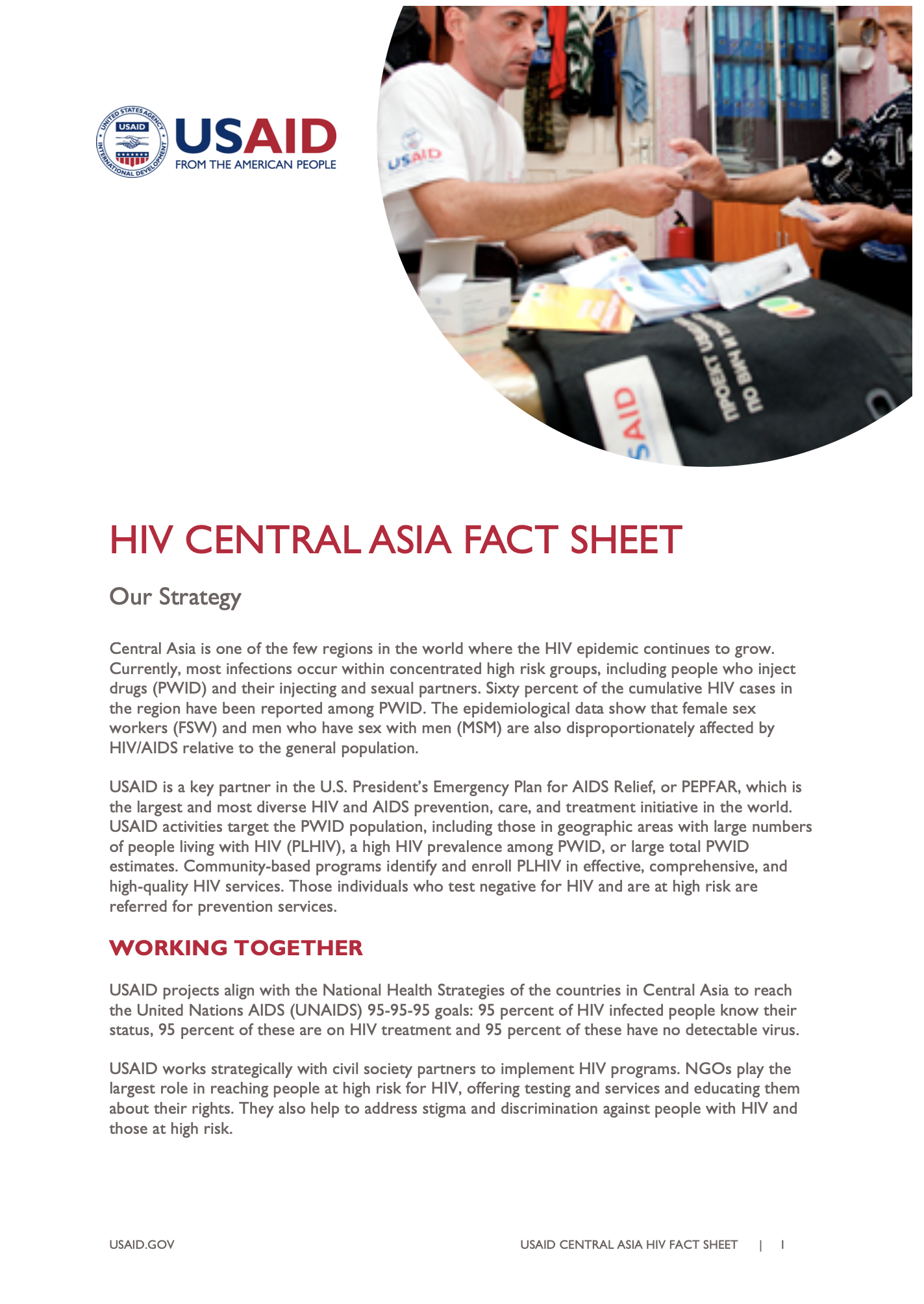Speeches Shim
HIV Central Asia Fact Sheet ![]() (pdf - 407k)
(pdf - 407k)
Our Strategy
Central Asia is one of the few regions in the world where the HIV epidemic continues to grow. Currently, most infections occur within concentrated high risk groups, including people who inject drugs (PWID) and their injecting and sexual partners. Sixty percent of the cumulative HIV cases in the region have been reported among PWID. The epidemiological data show that female sex workers (FSW) and men who have sex with men (MSM) are also disproportionately affected by HIV/AIDS relative to the general population.
USAID is a key partner in the U.S. President’s Emergency Plan for AIDS Relief, or PEPFAR, which is the largest and most diverse HIV and AIDS prevention, care, and treatment initiative in the world. USAID activities target the PWID population, including those in geographic areas with large numbers of people living with HIV (PLHIV), a high HIV prevalence among PWID, or large total PWID estimates. Community-based programs identify and enroll PLHIV in effective, comprehensive, and high-quality HIV services. Those individuals who test negative for HIV and are at high risk are referred for prevention services.
WORKING TOGETHER
USAID projects align with the National Health Strategies of the countries in Central Asia to reach the United Nations AIDS (UNAIDS) 95-95-95 goals: 95 percent of HIV infected people know their status, 95 percent of these are on HIV treatment and 95 percent of these have no detectable virus.
USAID works strategically with civil society partners to implement HIV programs. NGOs play the largest role in reaching people at high risk for HIV, offering testing and services and educating them about their rights. They also help to address stigma and discrimination against people with HIV and those at high risk.
USAID works with UNAIDS, United Nations Office on Drugs and Crime, the Global Fund, and other United States government agencies to coordinate the region’s response to HIV and AIDS.
What We Do
In coordination with the U.S. Centers for Disease Control and Prevention (CDC), USAID locates PWID and other high-risk groups through a range of innovative peer network driven approaches. Peer navigators working with community-based organizations use these approaches to offer HIV testing to those at high risk, identify PLHIV, and provide them access to comprehensive HIV/AIDS prevention, treatment, and care services. USAID works to reduce the barriers that prevent people from learning their status and limit their access to services. USAID also supports legal advocacy efforts and human rights training.
TREATMENT AND CARE
USAID focuses on improving systems that promote adherence to and retention in life-saving antiretroviral treatment for people living with HIV. This is vitally important, because in addition to saving clients’ lives, HIV treatment lowers the amount of virus in the body and can greatly reduce the risk of transmitting HIV to others.
INSTITUTIONAL CAPACITY
USAID strengthens the capacity of national and local institutions, NGOs, and individuals to more effectively lead the planning, delivery, and monitoring of quality services to key populations and to advocate for improved policies and access to services.
Projects
- USAID’s HIV Flagship and Meeting Targets and Maintaining Epidemic Control projects work to increase the use of evidence-based government- and NGO-provided HIV prevention, treatment, and care services for people living with HIV and for high risk groups: people who inject drugs, prisoners, sex workers, and men who have sex with men. Through the use of peer counselors, these projects are able to reach high risk individuals who are otherwise not reached with health services.
- The LEADER for People Living with HIV project works to strengthen the capacity of civil society to more effectively address stigma and discrimination, advocate for equitable access to comprehensive prevention, treatment, and care, and address human rights issues affecting people living with HIV.
- The USAID Global Health Supply Chain - Procurement and Supply Management project provides technical assistance across the region to strengthen the supply chain, ensuring that HIV diagnostics and treatment are available when and where they are needed.


Comment
Make a general inquiry or suggest an improvement.